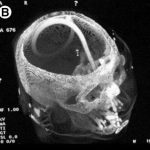Smaller trauma hospitals, both designated and undesignated, are the front line for the initial care of the majority of trauma patients. Many patients can be evaluated and sent home or admitted to the initial hospital. More severely injured patients are commonly transferred to the nearest Level I or Level II trauma center for care of injuries requiring specialists.
Imaging studies such as conventional xray and CT scan are a necessary part of the initial trauma evaluation. But is it necessary to do a full radiographic evaluation, even when it is known that the patient will have to be transferred?
Researchers at Dartmouth Hitchcock Medical Center examined the issue of repeat imaging at their Level I center. They looked at 138 patients that were transferred to them from other rural hospitals. They found that 75% underwent CT scanning prior to transfer, and 58% underwent repeat scanning upon arriving at Dartmouth.
The authors discovered the following:
- Head CTs were repeated 52% of the time, primarily due to clinical indications
- Spine reconstructions were repeated 33-50% of the time due to inadequate reconstruction technique
- Chest (31%) and abdomen (20%) were repeated due to inappropriate use of IV contrast
- 13% of image disks used incompatible software
- 7% of images were not sent with the patient
Here are my recommendations for imaging by hospitals that refer patients to Level I or II trauma center:
- Obtain the essential plain films recommended by ATLS (chest, pelvis)
- If an obvious injury requiring transfer is found on exam (e.g. open fracture) do no further studies
- Obtain any imaging studies needed to decide if you can admit the patient to your own hospital (example: abdominal CT for abdominal pain and negative FAST. Keep if no injury, transfer if solid organ injury)
- As soon as an injury is identified that mandates transfer, do no further studies
- Always send image disks with the patient
- Work with your referral trauma center to obtain a copy of their CT imaging protocols so if you do need to perform a study you can duplicate their technique
Reference: Gupta et al. Inefficiencies in a Rural Trauma System: The Burden of Repeat Imaging in Interfacility Transfers. J Trauma 69(2):253-255, 2010.




